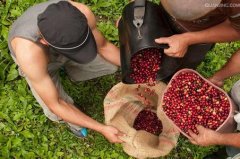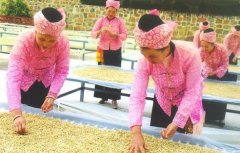A brief introduction to the baking degree of fine coffee beans by grinding and scale treatment in Flint Manor of Panama

There are also many excellent manors in Pokuit, except the famous Emerald Manor, Alida Manor, Aqaba Manor and so on, all of which produce high-quality boutique coffee. This is not only due to the superior ecological conditions of the Pokuit region of Panama and the fertile volcanic ash soil of the Baru volcanic land. Another important factor is that the microclimate in the Poquet Heights of Panama is a unique and important resource for boutique coffee in the Pokuit region. This is the Panamanian environment from east to west, which allows the cold air to converge over 6500 feet through the Central Mountains, thus creating a variety of microclimates in the Pokuit region, making its temperature and rainfall very suitable for plant growth. so the coffee trees grown here are in good condition.
In the land of Pokuit, there is a bean with a high performance-to-price ratio. And it has a very beautiful name-Flower Butterfly. She has 40% high-quality Rosa pedigree, which is composed of Rosa, Kaddura and Kaduai. It is planted in the Baru volcano region of Pokut and grows in the volcanic area at an altitude of 1600 meters. The treatment plant uses fine washing treatment. Panama's special local microclimate leads to abundant rainfall in this area, and a large temperature difference between day and night, coupled with the unique volcanic rock and soil of the volcanic area, as well as meticulous harvesting and fine treatment. It makes this coffee perform well in terms of firmness, acidity and floral aroma.
Honey treatment is the way to treat the coffee with pectin and endocarp after the peel and flesh are removed. The key to distinguish between different honey treatments lies in the choice of the remaining pectin: retaining the proportion of pectin and drying speed and method.
Yellow honey: about 40% of the pectin is removed; the drying method requires the most direct heat absorption, receives the most light drying, and lasts for about 8 days to reach a stable water content.
Red honey: about 25% of the pectin is removed; it takes longer to dry than yellow honey, and reduces direct exposure to sunlight, even in shading sheds, lasting about 12 days.
Black honey: hardly remove pectin; dry for the longest time, lasting at least 2 weeks, with a cover to avoid too strong sunlight, prevent drying too fast, and make sugar conversion more fully.
Important Notice :
前街咖啡 FrontStreet Coffee has moved to new addredd:
FrontStreet Coffee Address: 315,Donghua East Road,GuangZhou
Tel:020 38364473
- Prev

Development of planting area treatment methods for Aimani Manor in Indonesia A brief introduction to varieties, climate and altitude
On the whole, Indonesian coffee has a strong flavor, mellow taste, slightly syrup flavor and excellent acidity, and its two main export markets are Germany and Japan, which reflects the excellent quality of the coffee. What attracts consumers is the unique quality of its Arabica coffee beans. You can add milk or cream to high-quality Indonesian coffee without worrying about the impact.
- Next

A brief introduction to the planting Market Environment of Panamanian Flint Manor Coffee varieties with fertile soil
At such a high altitude, the low temperature delayed the ripening of the coffee berries, about a month later than the normal ripening period, while the fertile volcanic soil provided sufficient nutrients for the coffee, coupled with the excellent microclimate brought by the Baru volcano, Elida Manor was able to achieve good results in cup test competitions. In addition to creating good conditions for coffee cultivation, run Elida Villa.
Related
- Does Rose Summer choose Blue, Green or Red? Detailed explanation of Rose Summer Coffee plots and Classification in Panamanian Jade Manor
- What is the difference between the origin, producing area, processing plant, cooperative and manor of coffee beans?
- How fine does the espresso powder fit? how to grind the espresso?
- Sca coffee roasting degree color card coffee roasting degree 8 roasting color values what do you mean?
- The practice of lattes: how to make lattes at home
- Introduction to Indonesian Fine Coffee beans-- Java Coffee producing area of Indonesian Arabica Coffee
- How much will the flavor of light and medium roasted rose summer be expressed? What baking level is rose summer suitable for?
- Introduction to the characteristics of washing, sun-drying or wet-planing coffee commonly used in Mantenin, Indonesia
- Price characteristics of Arabica Coffee Bean Starbucks introduction to Manning Coffee Bean Taste producing area Variety Manor
- What is the authentic Yega flavor? What are the flavor characteristics of the really excellent Yejasuffi coffee beans?

